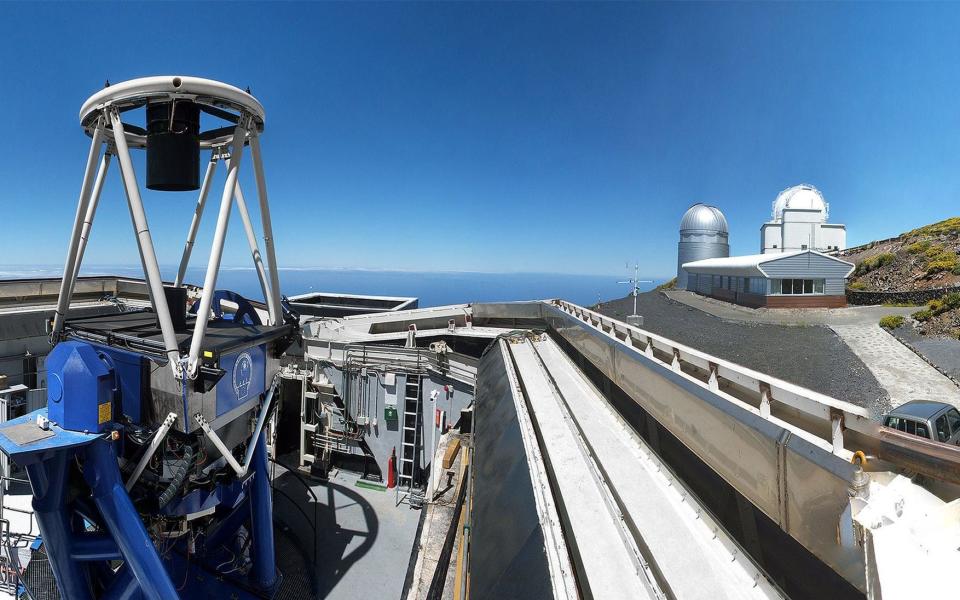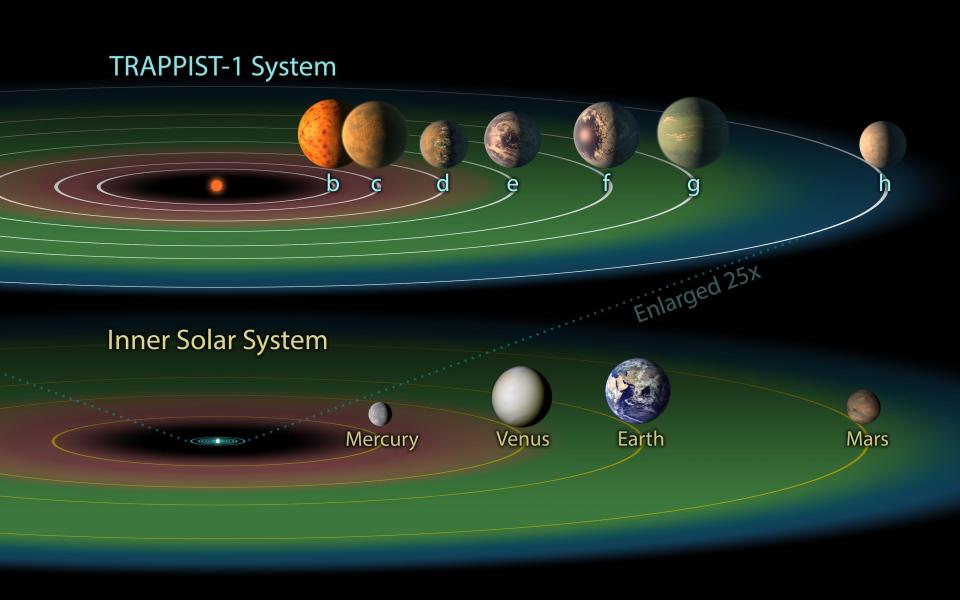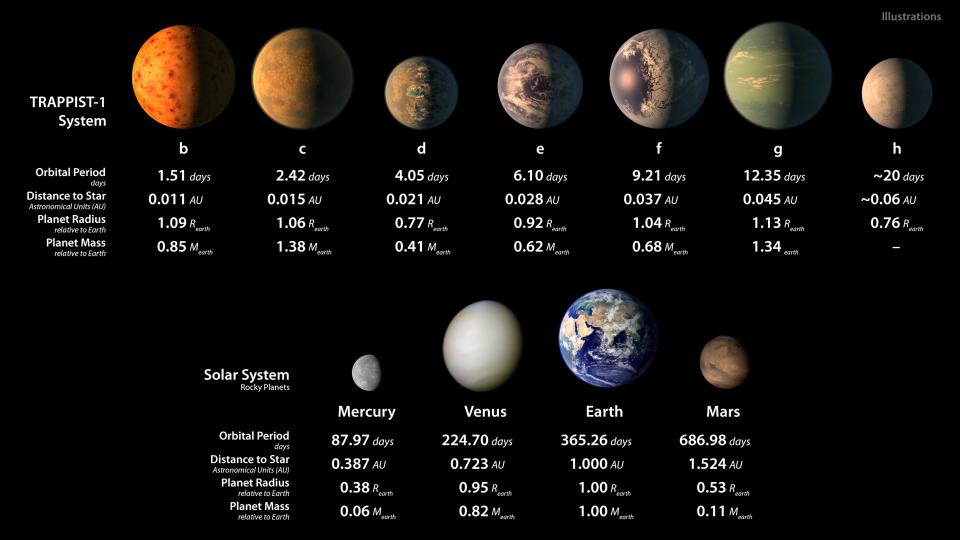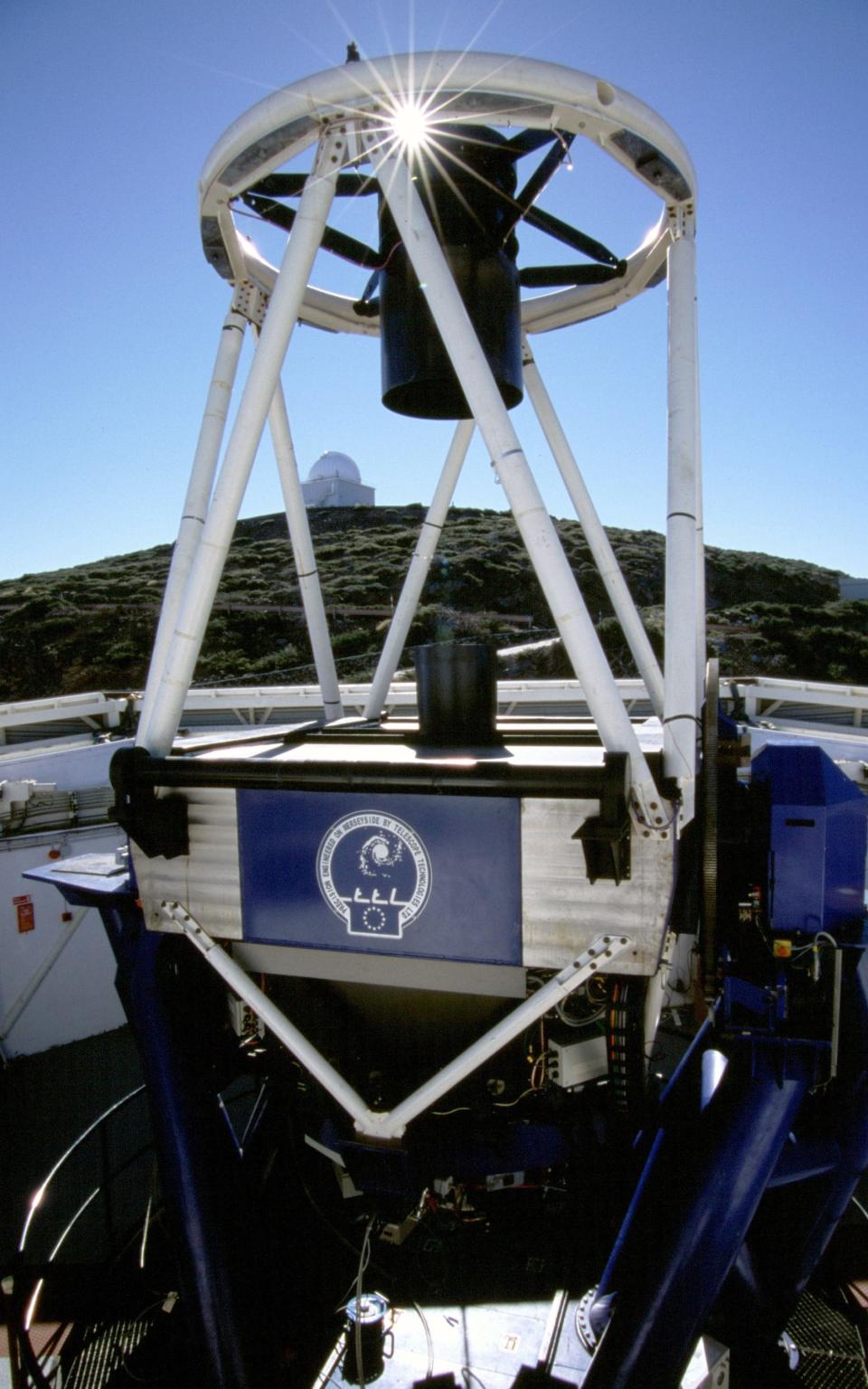Nasa discovers new solar system TRAPPIST-1 - where life may have evolved on three planets
Life may have evolved on at least three planets within a newly discovered solar system that is 39 light years from Earth, it was announced last night.
Astronomers at the National Aeronautics and Space Administration (Nasa) have detected no less than seven roughly Earth-sized worlds orbiting a dwarf star in the system, it was announced today.
Scientists had previously only identified a tiny number of so-called “exoplanets”, which are believed to have the qualities needed to support life.
However, the new system contains an unprecedented number of Earth-sized, probably rocky planets, and is being hailed as an “accelerated leap forward” in the search for extraterrestrial life.
Three of the new planets are said to be particularly promising because they could sustain oceans. Thomas Zurbuchen, associate administrator of Nasa’s Science Mission Directorate, told a press conference in Washington: “This gives us a hint that finding a second Earth is not a matter of ‘if’, but ‘when’.”
The planets were detected using Nasa’s Spitzer Space Telescope and several ground-based observatories. Lead researcher Michaël Gillon, of the University of Liège, said: “The planets are all close to each other and very close to the star, which is very reminiscent of the moons around Jupiter.
“Still, the star is so small and cold that the seven planets are temperate, which means that they could have some liquid water – and maybe life, by extension – on the surface.”
The team determined that all the planets in the system are similar in size to Earth and Venus, or slightly smaller. And density measurements suggest that at least the innermost six planets are rocky. Because the star is so dim, the planets are warmed gently despite having orbits much smaller than that of Mercury, the planet closest to our Sun.
Key observations were made by the Trappist robotic telescope at La Silla, Chile which gives the system its name. Three planets – classified as TRAPPIST-1e, f and g – orbit in the “habitable” or so-called “Goldilocks” zone where temperatures are suited to surface oceans of liquid water.
The star at the center of the solar system has a temperature of 2550K and is at least 500 million years old. In comparison, the Sun is about 4.6 billion years old and has a temperature of 5778K. The six inner planets lie in a temperate zone where surface temperatures range from zero to 100C.
Nasa’s Hubble Space Telescope is already being used to search for atmospheres around the planets. Future telescopes, including the proposed European Extremely Large Telescope and the James Webb Space Telescope, may be powerful enough to detect markers of life, such as oxygen, in the atmospheres of exoplanets.
One of the great questions of all time is whether we are alone in the universe
Paul Hertz, director of the Astrophysics Division, NASA in Washington
Prof Sara Seager, an expert in planetary science and physics at the Massachusetts Institute of Technology, said: “In this planetary system, Goldilocks has many sisters.
We have made a giant accelerated leap forward in the search for habitable worlds and life in other worlds,” she said. The Spitzer telescope, which uses infrared technology, was able to track how fast each of the planets crossed TRAPPIST-1 and completed an orbit.
From this the research team calculated how far the planets were from their star, and therefore how likely they are to be habitable. They were assisted by astronomers from Liverpool John Moores University, operating a ground-based telescope in the Canary Islands.
British astronomer Dr Chris Copperwheat, from Liverpool John Moores University, who co-led the international team said: “As a robotic telescope and the largest in the world, the Liverpool telescope is very sensitive to the small, less than 1 per cent, dips in brightness through which the planets are discovered.”
Nasa discovers the TRAPPIST-1 Star with 7 Earth-size planets in its orbit, in pictures
The new planets are very close to each other and Dr Gillon said a person standing on the surface of one would have a view of its neighbours, similar to seeing the Moon from Earth.
The first exoplanet was confirmed to have been discovered in 1992, since when a total of 3,577 have been found. Of these, less than a dozen are thought to be well suited to supporting life, and Nasa said only three previously known exoplanets were as ideal as those in the new solar system.
Around a fifth of Sun-like stars are thought to have an Earth-sized planet in their habitable zones. Astronomers estimate there could be as many as 40 billion potentially habitable worlds in our galaxy, the Milky Way. Prof Zurbuchen said that now was a “gold-rush phase” in the search for these exoplanets.
“This is going forward at a rapid pace not just because of the telescopes there, but the telescopes we are launching soon,” he said.
Dr Copperwheat, added: "The discovery of multiple rocky planets with surface temperatures which allow for liquid water make this amazing system an exciting future target in the search for life."
A robotic telescope operated by Liverpool John Moores University played a major role in the discovery reported in the journal Nature.
It was one of a number of ground-based instruments that supported observations made by American space agency Nasa's orbiting Spitzer telescope.
The Liverpool telescope helped detect the planets as they passed in front of their star.
NASA Greatest Achievements and Discoveries, in Pictures
The planets were found using the "transit" method that looks for tiny amounts of dimming caused by a world blocking light from its star.
The Liverpool Telescope is located on La Palma in the Canary Islands.
Astronomer Royal Sir Martin Rees thinks he discovery of these new worlds is just the start. There are many more life-supporting planets out there waiting to be discovered he says...
Another view of the TRAPPIST-1 system
TRAPPIST-1 "provides humanity w/ its first opportunities at discovering evidence of biology beyond the Solar system"https://t.co/iav8Z6jMUYpic.twitter.com/IiDr777SmJ
— Eric Holthaus (@EricHolthaus) February 22, 2017
This the bottom axis is in astronimical units. A unit of measurement equal to 149.6 million kilometres, the mean distance from the centre of the earth to the centre of the sun. But you knew that.
Here's another 'Chronicles of Riddick-like' image...
These worlds have sizes and temperatures similar to those of Venus and Earth and are the best targets found so far for the search for life outside the Solar System. They are the first planets ever discovered around such a tiny and dim star.
In this view one of the inner planets is seen in transit across the disc of its tiny and dim parent star.
And here's how the internet reacted...
Large numbers of people speculated excitedly that the space agency was about to confirm the existence of aliens, while a significant section of more serious-minded Tweeters asserted that it definitely wouldn't be aliens.
Some of the Twitter reaction is here.
Nasa has a way with images.
The TRAPPIST-1 star & 7 Earth-sized planets orbiting it, are relatively close to us; located ~40 light-years away: https://t.co/QS80AnZ2Jgpic.twitter.com/GiKAFXyNvo
— NASA (@NASA) February 22, 2017
Here's how the new planets stack up against ours
The above image show how our solar system compares the new one. All seven planets are within 20 per cent of the size and mass of our own planet and almost certainly rocky, and three are ideally situated to harbour life-nurturing oceans of water.
Gold Rush Phase
Thomas Zurbuchen says we are now in the 'gold rush phase' in the search for exoplanets.
"This is going forward at a rapid pace," he says. "Not just because of the telescopes there, but because of the telescopes we are launching soon."
The long-lensed explorer for Liverpool...
The Liverpool Telescope is located on La Palma in the Canary Islands where the skies are clear most of the the time.
Written off
Sara Seager says that when she and her colleagues started looking for exoplanets 20 years ago they were 'written off' by other scientists.
"This is a search that will go on for many generations," she said.
"The fact that we're so close now to finding many habitable worlds is very exciting."
Planet rock
This image provided by NASA/JPL-Caltech shows an artist's conception of what the surface of the exoplanet TRAPPIST-1f may look like, based on available data about its diameter, mass and distances from the host star.
This looks like some sort of Jules Verne nightmare though.
Ale-ien lifeforms?
When asked if the planets will be named, Michael Gillon, astronomer at the University of Liege, says the team had discussed naming adding to the Trappist theme (the monks who brew) by naming them after Belgian beers. ("Set a course for Planet Duvel...")
The traditionalists will be hopping mad if this doesn't happen.
Extrapolations..
Sean Carey, manager of Nasa's Spitzer Science Center, explains that his scientists can tell how far these exoplanets are from their TRAPPIST-1 star, thus indicating how habitable they are, by observing how long they take to cross it and come back around.
In case you're not keeping up with the terminology
Goldilocks has many sisters
Sara Seager, professor of planetary science and physics at Massachusetts Institute of Technology, says: "In this planetary system, Goldilocks has many sisters.
"We have made a giant accelerated leap forward in the search for habitable worlds and life in other worlds."
The Goldilocks zone describes the placing of a planet at a distance form its star which makes life most likely. That is why Nasa is so excited by these new exoplanets.
A second Earth: 'not if, but when'
Thomas Zurbuchen, associate administrator of the Science Mission Directorate at Nasa, says: “This gives us a hint that finding a second earth is not just a matter of if, but when.
“You can just imagine how many worlds are out there that could have a habitable ecosystem that we can explore.”
Goldilocks planets discovered!
Nasa have discovered six inner planets which can support life - not too hot and not too cold.
Of these, at least three are thought to be capable of having oceans...
Less than 10 minutes..
Nasa will make its exoplanet announcement at 6pm GMT
Oh, so not aliens then
Pssst! We've got exciting news from beyond our solar system! Spoiler: NOT aliens. Watch at 1pm ET: https://t.co/mzKW5uV4hS Q? Use #askNASApic.twitter.com/uHremmTTqK
— NASA (@NASA) February 22, 2017
Exoplanets
The first was detected in 1988 but not confirmed since 1992.
Since then telescopes have discovered more than 3,500 planets.
Kepler telescope is the star of the show
Kepler is the space observatory launched by Nasa to discover Earth-size planets orbiting other stars. Named after astronomer Johannes Kepler, the spacecraft was launched on March 7, 2009, into an Earth-trailing heliocentric orbit.
Nasa certainly seem excited
New discovery! We're announcing findings on planets orbiting stars other than our sun today at 1pm ET: https://t.co/PYO7Arxtjb Q? #askNASApic.twitter.com/7ua38zFfpW
— NASA (@NASA) February 22, 2017
Catchy name..
Not quite - HD 219134b is the name of the closest known rocky exoplanet to Earth (a mere 21 light years away), which was detected in part from data gleaned by Spitzer.
But since being discovered in 2015 it has been ruled out as suitable for life because it sits too close to its star, meaning temperatures are too high.
'Great observatory'
The Spitzer Space Telescope was launched in 2003 and uses infrared technology to examine planets light years away.
After 4,930 days in space the telescope, the fourth and final element of Nasa's Great Observatories programme, the craft is now more than 145 million miles from Earth.
It was named, following a public vote, after Lyman Spitzer, a major champion of space telescopes in the 1940s.
In just under 75 minutes we will know what new worlds it has seen.
90 minutes to go
Nasa has given few clues as to its announcement at 6pm GMT, but we do know scientists from its Spitzer telescope will be at the press conference.
They spend their time observing 'exoplanets', and in particular looking for ones similar to Earth that could support life.










